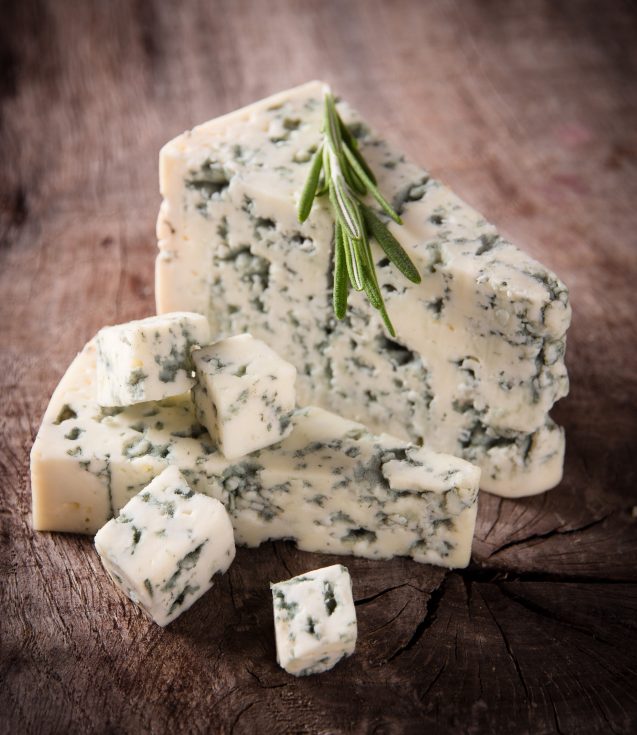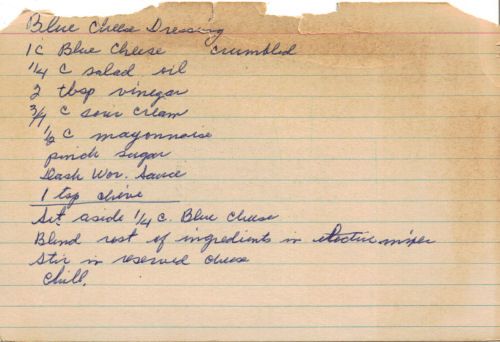
by Gary Allen
Roquefort cheese has been made in the caves of Combalou, Roquefort-sur-Soulzon, at least since Gaul was occupied by the Romans — Pliny the Elder spoke highly of it, and he was not the sort who normally gushed gourmet superlatives. By 1411, Les Causses had been granted the exclusive right to the name “Roquefort,” and all other blue-veined cheeses had to make their own reputations. Salads, of course, go back much further — they were known to the ancient Greeks — but didn’t have an entire book devoted to them until 1699, when Robert Evelyn published his Acetaria: A Discourse on Sallets.
When salad and Roquefort cheese first got together is somewhat more mysterious. Usually, recipes just “happen,” they evolve — often in several places at the same time — in response to new tastes, the availability of new ingredients, etc. Recipes, or “receipts,” have only found their way into print after a sufficient number of people found them useful. Only rarely can we provide, with any certainty, the “who, what, where, when and how” of a recipe’s creation.

We can look for clues to “who, what, where, when and how” it might have been invented though. We know that Roquefort Dressing did not first appear in France — the French preferred simple vinaigrettes on their salads and thought too highly of the great cheese to reduce it to the status of a mere ingredient in something else.
We also know that Roquefort cheese was fairly well-known in the U.S, at least as early as the 1850s. Thomas Jefferson would surely have known about it over fifty years earlier, and he was very fond of salads, but they tended to be dressed with egg-yolk-thickened dressings.
Homans Isaac Smith wrote, in 1859: “In France, the Roquefort cheese is the most esteemed, and next, that of Neufchatel. The former somewhat resembles Stilton, but is much inferior; and the latter is a cream cheese, seldom exceeding a quarter of a pound.”
Elliot G. Storke, also writing in 1859, agreed with Smith: “In France, the Roquefort cheese is compared to our Stilton, but is much inferior, although a good cheese. The little cheeses made from cream and folded in paper, called Neufchatel cheeses, are imported from France as a delicacy.”
Apparently, Mr. Smith’s and Mr. Storke’s tastes were still primarily British, long after America had gained independence. One traveler, writing in Appletons’ Journal: A Magazine of General Literature, in 1875, had a somewhat different opinion of the cheese: “If America ever produced cheese equal to that delicious green-streaked cream, which is known as the Roquefort, its manufacture may surely be ranked among the forgotten arts.”

Wirt Sikes, traveling to Brussels, complained about his accommodations in a hotel there:
There was no gas, and the dim light of the solitary candles did not produce a cheerful effect. There was no fireplace in either room, and we could not get warm. Weary and worn, chilled and hungry, we dejectedly ordered a cold chicken and a bit of Roquefort cheese to be served in my room, for the dining-room was closed and the kitchen-fires were out, although it was not yet midnight. The chicken came, but no Roquefort; they had only Stilton and Cheshire, the waiter said, in English. In fact, we had chanced upon the particular hotel in Brussels where they give you the English language in lieu of comfort, and English dishes in lieu of good living.
By the 1870s American palates had clearly become more sophisticated!
Salads with “French dressings” (vinaigrettes with various additions) became fashionable in America in the 1880s, but in the cookbook assembled by the Board of Lady Managers of the World’s Columbian Exposition, no mention of Roquefort Dressing appeared.

Fannie Farmer’s original 1896 Boston Cooking-School Cook Book used “French dressing” in the vinaigrette sense, and included some 13 recipes for salad dressings, but none of them resembles Roquefort Dressing. Several had creamy textures, but they were cooked and contained cream and/or egg yolks. This is hardly surprising, as she doesn’t even list Roquefort among the cheeses she included in her book. Curiously, she does mention three mold-veined cheeses: Cheshire, Gorgonzola, and Stilton.
In 1915, Hellmann’s mayonnaise first appeared in jars, and salad dressings began to multiply — Ranch, Green Goddess and a new sweet-sour orange concoction called “French Dressing” (that had nothing whatsoever in common with the traditional vinaigrettes) — soon appeared on grocers’ shelves.

By the 1920s, green salads became popular — first in California, and then across the country (especially in the new tearooms that catered to a female clientele). According to Jan Whitaker, “Salads, called ‘the thinking woman’s luncheon, and the university girl’s dessert,’ were also popular attractions in tearooms.”
Finally, in the salad dressing recipes in 1928’s Edgewater Beach Hotel Salad Book, we find:
…classified under the headings of French Dressings, Mayonnaises, Boiled Dressings, Sour Cream Dressings, Vinegars, and Miscellaneous Dressings . . . the final section [was] devoted to . . . the four universally used dressings, French, Mayonnaise, Roquefort, and Thousand Island.
So, somewhere before 1928, Roquefort Salad Dressing “just happened” and became popular enough that it became standard almost immediately. What were its immediate precursors; what sorts of things were people eating that might have planted the idea of the dressing in the public mind? One recipe, by Rufus Estes, chef for two presidents (Grover Cleveland and Benjamin Harrison), and and one of the first African-Americans to write and publish a cookbook, in 1911, is suggestive:
Trianon Salad — Cut one grapefruit and two oranges in sections and free from seeds and membrane. Skin and seed one cup white grapes and one-third cup pecan nut meats in small pieces. Mix ingredients, arrange on a bed of romaine and pour over the following dressing: Mix four tablespoons olive oil, one tablespoon grape juice, one tablespoon grape vinegar, one-fourth teaspoon paprika, one-eighth teaspoon pepper and one tablespoon finely chopped Roquefort cheese. This dressing should stand in the ice-box four or five hours to become seasoned.
Fannie Farmer, in 1918, wrote a recipe that was a little more like what we think of when we hear the term “Roquefort Dressing”:
Tomato and Cheese Salad
Peel six medium-sized tomatoes, chill, and scoop out a small quantity of pulp from the centre of each. Fill cavities, using equal parts of Roquefort and Neufchâtel cheese worked together and moistened with French Dressing. Arrange on lettuce leaves and serve with French Dressing.”
By 1947, The Boston Cooking-School Cook Book had two versions of a dressing we would immediately recognize. Both were based on “French Dressing” (that basic vinaigrette) with crumbled Roquefort added; one also contained mayonnaise.

Roquefort French Dressing
Add 1 to 4 Tablespoons dry Roquefort cheese crumbs and a few drops of onion juice.
and:
Roquefort Cheese Dressing
2 Tablespoons mayonnaise
French Dressing
2 Tablespoons Roquefort Cheese
1/2 teaspoon Worcestershire sauce
Mix mayonnaise and cheese and add French dressing very slowly; then add Worcestershire sauce. Cream cheese or Roquefort-flavored cream cheese may be used in place of Roquefort.
The first Fannie Farmer recipe is almost identical to the one in Irma Rombauer’s Joy of Cooking (first published 1931), which means the dressing had become a standard by that time.

Roquefort or Blue Cheese French Dressing
Prepare: 1/2 Cup French Dressing
Beat into it 2 Tablespoons or more crumbled Roquefort or blue cheese.
We do know the particulars on some Roquefort recipes, however. Cobb salad (which contained Roquefort, but crumbled on top of the vinaigrette, not blended in, rather like Este’s Trianon Salad) was invented at the Original Hollywood Brown Derby, in 1937 by owner Bob Cobb. The best-known dish making use of Roquefort Dressing is Buffalo Chicken Wings, a dish invented by Frank and Teressa Bellissimo, at the Anchor Bar, 1047 Main Street, Buffalo, New York. The hot-sauce-drenched wings, accompanied by celery sticks and Roquefort Dressing, were first served in 1964.

And yes, even the details of the history of recent inventions such as Buffalo Chicken Wings, are hotly argued (there wouldn’t be a need for food historians if all the answers were easy), but you can sort through the accounts for yourself at On the Wings of a Buffalo or ‘Mother Teressa’s Wings.’
Bibliography
Anderson, Jean. American Century Cook Book: The Most Popular Recipes of the 20th Century. New York: Clarkson Potter, 1997.
Carr, Sandy. The Simon & Schuster Pocket Guide to Cheese: A Complete Guide to the Cheeses of the World. New York: Simon & Schuster, 1992.
Estes, Rufus. Good Things to Eat. Chicago: Rufus Estes, 1911.
Farmer, Fannie Merritt. The Boston Cooking-School Cook Book. Boston: n.p., 1896 (facsimile of the 1st ed.; New York: Weathervane Books/Crown, 1973).
The Boston Cooking-School Cook Book. 1918, online.
The Boston Cooking-School Cook Book. (eighth ed.; edited & updated by Wilma Lord Perkins), Boston: Little, Brown & Co., 1947.
Hatch, Peter J. “Thomas Jefferson’s Favorite Vegetables,” Twinleaf Journal, Thomas Jefferson Foundation, Inc., 2002, available at Twinleaf Journal Online.
Hess, John L. and Karen Hess. The Taste of America. New York: Viking/Grossman, 1977.
L., E. H., “America seen with Foreign Eyes, Chapter VI,” Appletons’ Journal: A Magazine of General Literature, Volume 13, Issue 326, June 19, 1875, pp.778-781.
Making of America (MOA) is a digital library of primary sources in American social history primarily from the antebellum period through reconstruction. It is available, online at MOA. Many of the books cited here were accessed at MOA.
Shircliffe, Arnold. Edgewater Beach Hotel Salad Book. Evanston, IL: Hotel Monthly Press, 1928.
Shuman, Carrie V. Favorite Dishes: A Columbian Autograph Souvenir Cookery Book. Chicago, 1893, available online at University of Pennsylvania Online Books.
Sikes, Wirt. “Six Hotels,” Appletons’ Journal: A Magazine of General Literature, Volume 1, Issue 1, July 1876, pp.14-19.
Smith, Homans, I. A Cyclopedia of Commerce and Commercial Navigation. 1859.
Storke, Elliot G. (ed.). Domestic and Rural Affairs. The Family, Farm and Gardens, and the Domestic Animals…From the Latest and Best Authorities. 1859.
Whitaker, Jan. Tea at the Blue Lantern Inn: A Social History of the Tea Room Craze in America. New York: St. Martin’s Press, 2002.
——————
This article originally appeared, in somewhat different form, in Sandy Oliver’s wonderful (and sorely missed) Food History News.
Gary Allen teaches food writing and food & culture courses at Empire State College, and has been—at various times—Vice President, Newsletter Editor and Webmaster for the Association for the Study of Food and Society, and Food History Editor at Leite’s Culinaria.
He has written, edited, or contributed to some forty-odd books. He also publishes a monthly newsletter for food writers, and maintains a website On the Table and blog Just Served.
|
|





















May 25, 2021
So what is the “French Dressing” recipe? This is very interesting.